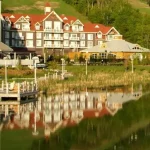Introduction to Sable Island: The Wild Horse Sanctuary of the North Atlantic
Whispers of adventure echo across the windswept dunes of Sable Island, an emerald thread in the vast tapestry of the North Atlantic. Sitting approximately 300 kilometers southeast of Nova Scotia, this sliver of sand, measuring just about 42 kilometers long, has captivated the imaginations of adventurers and nature lovers alike. This crescent-shaped isle, often shrouded in mist and mystery, is home to a rare ecology that includes the legendary herds of wild horses for which it is renowned. A land where nature reigns supreme, Sable Island offers a sanctuary not just for its equine inhabitants but also for the diverse wildlife that thrives along its shoreline and grasslands.
From the symphony of roaring ocean waves to the dance of wild manes in the breeze, the island invites a step back into a world where the footprints of modern life are washed away with the tide. Sable Island’s enchanting beauty lies not just in its untamed wildness but in its sincerity as an environmental haven, a living canvas displaying the intricate balance of life in a remote and unique ecosystem.
Historical Context: The Story of Sable Island
Sable Island’s historical tapestry is rich with tales of shipwrecks, lifesaving, and survival. The notorious sandbanks surrounding the island, often concealed by a relentless fog, have claimed over 350 ships since the 16th century, earning it the ominous title of “Graveyard of the Atlantic”. The island’s strategic — yet perilous — location inspired the establishment of life-saving stations in the 19th century, where courageous staff aided shipwrecked sailors, attempting to rescue both lives and cargo from the island’s ravenous grasp.
Throughout its history, the island has seen transient populations of sealers, shipwreck survivors, and even erstwhile settlers who attempted to tame its wild nature. Despite these sporadic human intrusions, Sable Island has largely resisted permanent habitation. In December 2013, the Canadian government recognized its ecological and historical significance, granting it the status of a National Park Reserve. This act ensured the protection of Sable Island’s diverse habitats, flora and fauna, and, of course, its iconic wild horses—a throughline from past to present in the island’s continuing narrative.
Architectural Splendor: Nature’s Own Handiwork on Sable Island
Amidst the fluid beauty of Sable Island, the term ‘architecture’ takes on a profound, organic meaning. The landscape here is not carved by human hands but shaped by the relentless forces of wind and water. The island’s architecture is found in the sweeping arcs of its sand dunes, standing as natural fortifications built up and constantly redesigned by the temperamental North Atlantic weather. These dynamic formations—some reaching heights of up to 30 meters—are the backbones of the island, cradling its delicate ecosystems within their sandy contours.
The few man-made structures that exist on Sable Island are designed with practicality and conservation in mind. The research and rescue facilities, such as the minimalist but sturdy Main Station Area and the weather station, are constructed to have minimal impact on the natural surroundings. These understated, functional buildings act as silent guardians over the island, blending into the landscape while serving essential roles in the ongoing study and protection of Sable Island’s unique environmental tapestry.
Encounters with Wildness: The Personal Experience of Visitors
Visitors to Sable Island are privy to an extraordinary personal encounter with the wild. Seeing the island’s famous horses—fabled to have descended from shipwrecked beasts of centuries past—is akin to stepping into the pages of an untold fable. These majestic creatures, neither shy nor tame, offer a profound connection to the unbridled essence of nature that is increasingly rare in our manicured world. They roam the island in bands, a living testament to the resilience and adaptation of life in harsh, isolated conditions.
While the wild horses are the star attraction, there is much more to Sable Island. The island shelters a plethora of avian species, a perfect haven for birdwatchers. The world’s largest breeding colony of grey Grey Origins & Evolution Nestled in the heart of Ontario, Grey County has a rich history that has seen it evolve from a quaint rural municipality to the bustling city it is today. Founded in 1852, the city has grown and developed significantly, embracing modernity while still preserving its historically significant structures and impressively maintained heritage sites. The city owes... seals is here as well, with their soulful eyes and playful demeanor creating a spectacle for wildlife enthusiasts. The orchestra of nature is complete with the haunting calls of seals, the squawking of seabirds, and the whisper of the island’s marram grass. This unspoiled gem offers a profound sense of solitude and introspection—a personal journey not just to a place, but to the heart of our own relationship with the natural world.
Grey Origins & Evolution Nestled in the heart of Ontario, Grey County has a rich history that has seen it evolve from a quaint rural municipality to the bustling city it is today. Founded in 1852, the city has grown and developed significantly, embracing modernity while still preserving its historically significant structures and impressively maintained heritage sites. The city owes... seals is here as well, with their soulful eyes and playful demeanor creating a spectacle for wildlife enthusiasts. The orchestra of nature is complete with the haunting calls of seals, the squawking of seabirds, and the whisper of the island’s marram grass. This unspoiled gem offers a profound sense of solitude and introspection—a personal journey not just to a place, but to the heart of our own relationship with the natural world.
The Evolution Over Time and the Cultural Mosaic of Canada
Sable Island’s role in Canada’s cultural tapestry has evolved dramatically over the centuries. From a deadly impediment to early navigators to a beacon of ecological and historical preservation, the island reflects the changing attitudes towards nature and conservation in Canadian society. It has become a symbol of wilderness protection and a microcosm of the country’s appreciation for its diverse natural landscapes. The wild horses, a critical part of Nova Scotia’s cultural heritage, have galvanized public interest and played a pivotal role in rallying conservation efforts for the island.
The story of Sable Island is ever-unfolding, as ongoing research provides insights into climate change and its effects on fragile coastal ecosystems. The island has become a living laboratory where scientists and conservationists can study untouched environments, adding significant chapters to our understanding of biodiversity and geophysical processes. The interweaving of Sable Island into Canada’s broader dialogues surrounding environment and culture continues, with its wild legacy serving as both a warning and a beacon of hope Hope Origins & Evolution Hope, the humble yet vibrant city at the confluence of the Fraser and Coquihalla rivers, traces its ancestry to the Sto:lo First Nations, who first inhabited this region. Officially established in 1858 during the Fraser Canyon Gold Rush, the city evolved rapidly, gaining prominence as a fur trade passage. Hope's railway legacy, facilitated by the Canadian... for the future of our planet.
Hope Origins & Evolution Hope, the humble yet vibrant city at the confluence of the Fraser and Coquihalla rivers, traces its ancestry to the Sto:lo First Nations, who first inhabited this region. Officially established in 1858 during the Fraser Canyon Gold Rush, the city evolved rapidly, gaining prominence as a fur trade passage. Hope's railway legacy, facilitated by the Canadian... for the future of our planet.
For those lucky enough to tread upon its shifting sands, Sable Island is never merely a destination but a transformative encounter with raw beauty and untold stories. As the wild horses race along the water’s edge, their manes catching foamy sprays of surf, water, wind, and sand weave a tale of survival and majesty. Whether basked in the golden Golden Origins & Evolution Golden, nestled in the Columbia River Valley, traces its roots back to the 1880s when European settlers arrived, anticipating prosperity from the Transcontinental Railroad project. The town soon thrived on lumber, agriculture, and mining, mercifully evading the ghost town fate of many contemporary boomtowns. Moreover, the arrival of Swiss guides in the early 20th century initiated... hues of sunrise or veiled by the silver fingers of fog, the island remains, as ever, a resting note in the melody of the wild Atlantic, a jewel of resilience in the crown of Canada’s landmarks.
Golden Origins & Evolution Golden, nestled in the Columbia River Valley, traces its roots back to the 1880s when European settlers arrived, anticipating prosperity from the Transcontinental Railroad project. The town soon thrived on lumber, agriculture, and mining, mercifully evading the ghost town fate of many contemporary boomtowns. Moreover, the arrival of Swiss guides in the early 20th century initiated... hues of sunrise or veiled by the silver fingers of fog, the island remains, as ever, a resting note in the melody of the wild Atlantic, a jewel of resilience in the crown of Canada’s landmarks.
Imagine yourself a solitary figure amidst the dunes, watching a canvas of stars unfold above as the day’s last light fades behind the world’s watery edge. Sable Island beckons not just as a remote strip of sand in the ocean, but as a living chronicle of the earth’s raw and rugged splendor—a refuge where the legacy of the past and the promise of the future are inscribed upon the land, calling out to the adventurer’s soul for a timeless and compelling journey.











